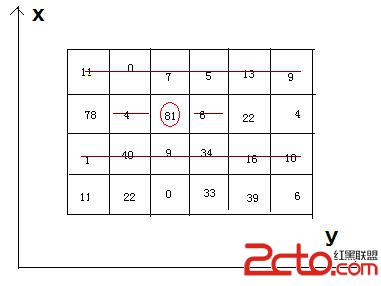HDU 2845 Beans (DP)
Problem Description
Bean-eating is an interesting game, everyone owns an M*N matrix, which is filled with different qualities beans. Meantime, there is only one bean in any 1*1 grid. Now you want to eat the beans and collect the qualities, but everyone
must obey by the following rules: if you eat the bean at the coordinate(x, y), you can’t eat the beans anyway at the coordinates listed (if exiting): (x, y-1), (x, y+1), and the both rows whose abscissas are x-1 and x+1.

Now, how much qualities can you eat and then get ?
Input
There are a few cases. In each case, there are two integer M (row number) and N (column number). The next M lines each contain N integers, representing the qualities of the beans. We can make sure that the quality of bean isn"t beyond
1000, and 1<=M*N<=200000.
Output
For each case, you just output the MAX qualities you can eat and then get.
Sample Input
4 6
11 0 7 5 13 9
78 4 81 6 22 4
1 40 9 34 16 10
11 22 0 33 39 6
Sample Output
242
題目可以看成是一個二維的,每一維的解法都是一個DP的過程,也就是一個數組,取第i個數就不能取與他相鄰的數,求和最大。
可以設兩個數組d[i],f[i]為別表示第i個數取或者不取時的和最大。
d[i] = f[i-1]+a[i] , f[i] = max(f[i-1],d[i-1]) 。f[1] = 0, d[1] = a[1] .
#include
#include
#include
#include
using namespace std;
typedef long long LL;
const int MAX=0x3f3f3f3f;
const int maxn = 200005;
int n, m;
int d[maxn], f[maxn], a[maxn], b[maxn];
int DP(int *c, int len) {
d[1] = c[1], f[1] = 0;
for(int i = 1; i <= len; i++) {
d[i] = f[i-1] + c[i];
f[i] = max(f[i-1], d[i-1]);
}
return max(f[len], d[len]);
}
int main()
{
while(~scanf("%d%d", &n, &m)) {
for(int i = 1; i <= n; i++) {
for(int j = 1; j <= m; j++)
scanf("%d", &a[j]);
b[i] = DP(a, m);
}
printf("%d\n", DP(b, n));
}
return 0;
}
